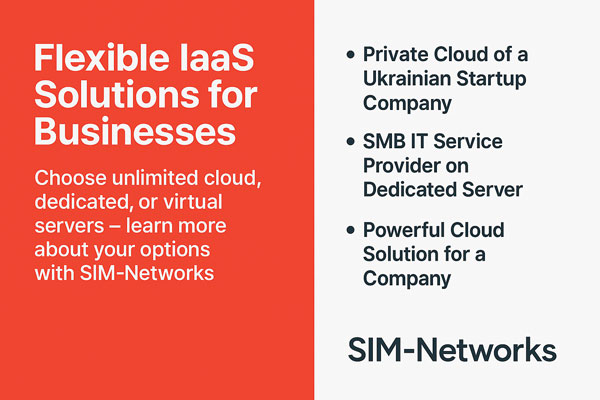The requirements for IT infrastructures are constantly evolving. While one company favours maximum control over its systems, another wants to be able to scale flexibly. The reality is that there is no one-size-fits-all standard solution. In this situation, many companies are looking for an infrastructure partner who not only provides servers, but also offers one thing above all: Freedom of design.
A look at the offering from SIM-Networks (https://www.sim-networks.com/en), an IaaS provider with data centres in Germany, shows how differently companies plan and use IT resources today and why the free choice of server type, hardware and configuration is becoming a decisive factor in many cases.
Not all servers are the same
Anyone who deals with Infrastructure-as-a-Service (IaaS) will quickly realise: The term covers a broad spectrum. From virtual machines and dedicated servers to complex cloud architectures, many things are theoretically possible. In practice, however, many companies quickly come up against limitations: Predefined hardware packages, inflexible tariff models or a lack of choice when it comes to server types often make a customised solution difficult.
SIM-Networks takes a different approach here. The company does not offer ready-made configuration packages, but allows customers to choose their infrastructure components freely, both in terms of the server type (dedicated, virtual, cloud) and the underlying hardware. This openness makes it possible to implement highly customised solutions. But what does this look like in practice?
Three use cases, three different requirements
To understand how flexible IaaS solutions can be, it is worth taking a look at specific customer projects. Three examples show how companies with different goals and framework conditions were each able to benefit from a configurable infrastructure in their own way.

1. a private cloud for Ukrainian start-ups
A company from Ukraine that specialises in supporting young tech start-ups needed an isolated cloud environment for its partner companies. It was not only important to protect sensitive data, but also to be able to use the environment independently for multiple projects.
The decision was made in favour of a private cloud solution with dedicated resources. The hardware used was specified precisely in advance, from the CPU to the memory layout. The result: a stable platform that can be flexibly expanded and offers a high level of security thanks to the physical separation of resources without the need for dedicated server rooms.
2. dedicated servers for an IT service provider in the SME sector
A German IT service provider with a focus on small and medium-sized enterprises wanted to modernise its hosting infrastructure. The requirements were clear: full control over the environment, guaranteed computing power, no “noisy neighbour” problem, as can occur in shared cloud environments. At the same time, operation should remain as low-maintenance as possible.</p
Here, the choice fell on server for companies. These are usually classic dedicated servers. Unlike many other providers, the company was able to specify the hardware in detail. The ability to select certain mainboard functions and RAID controllers that were compatible with existing systems was particularly helpful. The solution used today forms the technical basis for a number of customer projects – stable, powerful and customised.</p
3. a cloud infrastructure for data-intensive applications
Another example: An international company in the field of data science and analytics was faced with the challenge of analysing large volumes of data in real time. Computing power, scalability and network performance were particularly crucial here.
SIM-Networks provided a high-performance cloud infrastructure that was specifically tailored to these needs. Computing power and RAM were closely customised to the actual requirements, the storage level was designed for SSD/NVMe and a redundant network connection was ensured. This not only enabled the company to speed up the analysis process, but also to react flexibly to changing project loads without having to make long-term investments in its own hardware.
Flexibility as a strategic advantage
What can be deduced from these cases? First and foremost, that there is no one right infrastructure. Every company has its own priorities, be it security, control, scalability or performance. The ability to choose between different server types and to determine the underlying hardware individually is therefore not a luxury, but often the prerequisite for being able to work efficiently.
For IT managers, this means that the choice of infrastructure partner should not only be based on price and familiarity, but also on the ability to provide customised solutions. Experience shows that rigid solutions quickly reach their limits, especially in more complex IT landscapes.
Conclusion: Customisation instead of compromise
Off-the-shelf infrastructure solutions may be sufficient in some cases, but those who value customisability and future-proofing should opt for a flexible IaaS offering. The examples show that very different IT concepts can be realised with the right partner, from private clouds to high-performance platforms.
In the end, what counts is that the IT fits the company, not the other way round.



